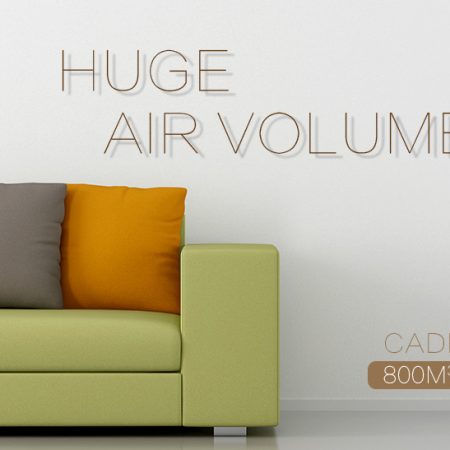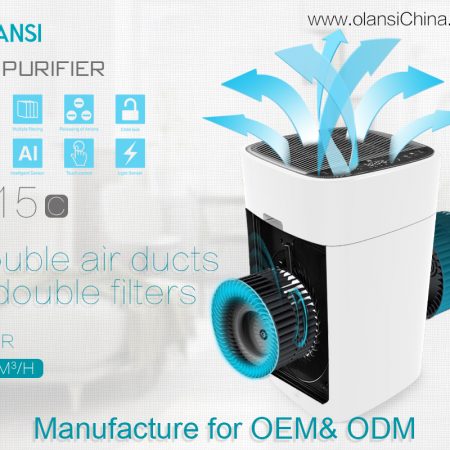What Should You Look for in an Air Purifier?
One of the first things to consider when you look for the right oem air purifier is its area coverage, or the size of room it can clean effectively. You want to make sure the purifier can clean the room it’s in, or there’s no point buying one. However, you don’t have to worry about buying an home air purifier that is too powerful for a given room. A high-powered hepa air purifier is preferable if you suffer from allergies, as it can clean the air in a room, a process also known as an air change, multiple times in an hour. For example, if you have a room that is around 250 square feet and you purchase a purifier that can make one air change an hour in rooms up to 500 square feet, you effectively have a purifier that will make two air changes every hour.
Cleaning Capabilities & Modes
One of the first things you’ll notice when you look for an air purifier is a series of numbers in the specifications for the CADR. These numbers indicate how effective the unit is at cleaning smoke, dust and pollen out of the air, which can carry pollutants or be harmful themselves. The higher the CADR rating for a specific particulate, the better it is at removing that substance from the air.
Part of what makes an air purifier efficient is its ability to move air through its system. For this reason, pay attention to the airflow and air changes per hour, as these specs determine how quickly the purifier can clean the air in a given room. Also check out how many cleaning cycles each machine has, as the more filters and cleaning cycles a machine has, the more opportunity it has to capture pollutants in the air.
Every china air purifier we reviewed uses HEPA filters, which are capable of removing 99.97 percent of small particles from the air. This filter type is an industry standard, so a purifier should use HEPA or equivalent filters. Many air purifiers use carbon pre-filters to capture larger particles so you don’t have to replace your HEPA filter as often, which can even reduce strong odors.
As we discussed earlier, many air purifiers come with alternative cleaning methods that have been met with scrutiny. First, some models use ionizers to charge particles as they pass through the machine so that they attach themselves to a surface, thus removing themselves from the air. These devices produce small amounts of ozone, though they meet the industry safety standard. If you are concerned with breathing ozone, look for a purifier that does not have this feature, or at least allows you to turn the ionizer off. Additionally, some models use UV light to try to sterilize these pollutants, though the effectiveness of this technology in air purifiers is highly debatable. Unless you want every method of air purification possible, you don’t have to focus on finding a model with UV lights.
Additionally, many air purifiers have a sleep, or quiet, mode that sets the machine at its lowest fan setting so it can run in your bedroom without disturbing your sleep. Some models even dim the lights or have an auto-adjust feature that changes the purifier’s settings after a few hours, usually eight, in this mode. Finally, look for an air purifier that has an auto mode, which uses an air-quality sensor to detect pollutants in the air and adjust the cleaning settings to meet what is needed. This feature maximizes the effectiveness and efficiency of the purifier, as it only runs on higher settings when needed.
Design
While you’re considering which air purifier is right for you, make sure you pay attention to the overall dimensions of the product. If you want to use the purifier in multiple rooms, moving it around as you need, make sure it is light enough to move or carry with ease. You also want to make sure you have enough space in the main room it will be in, because purifiers work best when they don’t have walls or furniture obstructing any airflow.
If you want to use the purifier while you sleep, make sure you understand how loud the unit is on its lowest settings. We tested the noise of all the air purifiers we reviewed on both their highest and lowest settings to give you an idea of how noisy they are. On average, the purifiers we tested reached around 30 dB, which is about the volume of a whisper, on their lowest settings. Air purifiers that make more noise than this average may be too disruptive for you to get restful sleep.
Also look for extra design features that add convenience. For example, with an operation timer, you can set the purifier to run for a few a few hours before it turns off automatically. Some models even allow you to schedule future times for the machine to turn on, which is highly convenient when you’re leaving for the day or on vacation.
Energy & Certifications
One of the first things to consider with any new appliance is the energy cost. Although the energy cost of one appliance may not be extensive, with all of our electrical devices these days, the electrical bill starts adding up. Look for an air purifier that doesn’t use an extensive amount of electricity so that you can save some money. On average, we found that air purifiers use around 86 watts of energy on their highest settings. Purifiers that use less energy on average will save you some money in the long run.
If saving energy is important to you, look for products that are Energy Star certified, as they are generally 20 to 30 percent more energy-efficient than what federal standards require. This also means that they are typically more energy-efficient than other products that don’t carry the Energy Star mark. There are also certifications that show products meet certain safety standards, such as UL and CARB designations.
Help & Support
Warranties protect you from manufacturer defects that cause the unit to malfunction, so your warranty can be the difference between a minor frustration with a faulty machine or the need to purchase a new purifier altogether. Warranties that last longer than a year give you the peace of mind that you aren’t going to have to break the bank if you find an issue with your air purifier.
Additionally, most companies offer an online user manual that you can download in case you lose the physical copy that comes with the model. Also look for a company that offers a FAQs page, as this level of support can answer many of your basic questions before you need to reach customer support. Some of the best companies offer live chat, which is an effective and convenient level of customer support. If you prefer to speak to a representative directly, look for a company that offers telephone support. Every company we reviewed offers email support.



